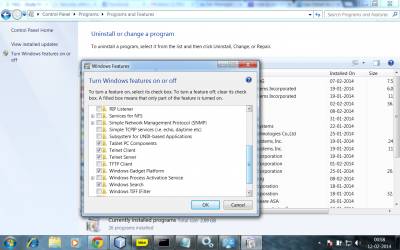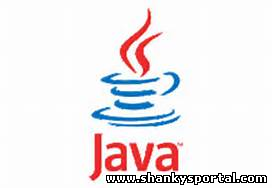| Home » FAQ | [ New question ] |
|
There are several domain registrar form where you can purchase a domain name of your wish. The best place to get a domain is Godaddy.com Here you can get a domain of your choice with best other features like web-hosting, email,privacy and security features. You can also get .in or others domains like .tk domain for free for unlimited period. |
|
Now you can make your computer speak anything that you want. Its very simple. You just have to create a small VB script file.
|
|
Difference between an Application Server and a Web server 1. Webserver serves pages for viewing in web browser, application server provides exposes business logic for client applications through various protocols 2. Webserver exclusively handles http requests.application server serves business logic to application programs through any number of protocols. 3. Webserver delegation model is fairly simple,when the request comes into the webserver,it simply passes the request to the program best able to handle it(Server side program). It may not support transactions and database connection pooling. 4. Application server is more capable of dynamic behaviour than webserver. We can also configure application server to work as a webserver.Simply application server is a superset of webserver. 5. Web Server serves static HTML pages or gifs, jpegs, etc., and can also run code written in CGI, JSP etc. A Web server handles the HTTP protocol. Eg of some web server are IIS or apache. 6. An Application Server is used to run business logic or dynamically generated presentation code. It can either be .NET based or J2EE based (BEA WebLogic Server, IBM WebSphere, JBoss). 7. A J2EE application server runs servlets and JSPs (infact a part of the app server called web container is responsible for running servlets and JSPs) that are used to create HTML pages dynamically. In addition, J2EE application server can run EJBs - which are used to execute business logic. 8. An Application server has a 'built-in' web server, in addition to that it supports other modules or features like e-business integration, independent management and security module, portlets etc. tomcat("web server”) |
|
robots.txt is a publicly available file related a website. It is a text file which contains rules to allow or disallow robots to crawl or index a website.
Suppose you want to restrict a particular user agent eg. googlebot to look into your website or a part of your website, you shoud write a robots.txt file and put it on the root directory of your website. The robots.txt should be located at:
Note:- If you dont want any user agents or robots to disallow to your site, you dont need a robots.txt at all.
We will see several examples of robots.txt and their meaning.
Each two lines in this file is considered as one entry. Now we will see the meaning of first line.
User-agent: *
This line indicates the User agenst or robots that will look into the website. "*" here means it is applicable to all the
user agents/robots. The second line "Disallow: /" indicates the url you want to block.i.e. here to disallow the entire directory "/" of your website.
In short, if a robots.txt contains above lines, your website is fully restricted from any crawler or bot to look into your website.
Suppose you have a /videos folder on your website that you dont want to be indexed by google's robot, you have to put below lines in the file:
So, the above file will tell the robots that is GoogleBot in this case, to index or look into all but the folder "/videos".
Now suppose there is one file /videos/demo.avi that you want to be searched and no other things. Then your robots.txt will look like:
Here, note that the directories are case sensitive. So, if the robots.txt has a line like: Disallow:/abc.html It will disallow the file abc.html but will not restrict Abc.html to be indexed/searched. Suppose we want to create a robots.txt which will block the entire site to be indexed but the google ads shoud be searched from your site then it should look like this:
|
|
If you get an error message like this:
C:\Users\shanky>telnet 'telnet' is not recognized as an internal or external command, operable program or batch file. It means that your system is not configured to use telnet service For this you need to enable telnet feature from control panel. Go to your control panel --> Programs and features Click on "Turn windows features on or off" Follow the figure. From the list of features, check the "Telnet server" :- To connect to your system remotely using using telnet "Telnet client" :- To use telnet to connect to any other remote machine. Click OK . This may take some time. Now go to your command line and type "telnet". you should get this prompt. Welcome to Microsoft Telnet Client Escape Character is 'CTRL+]' Microsoft Telnet> Done. You are good to go. Now if you want to check if you can connect to a telnet server, type "o news.thundernews.com" inside telnet prompt. You will get a welcome message like this: 200 Welcome (fx27.iad) That's it.Telnet is working fine.Now type "quit" to exit. |
|
Suppose you have a C program and you want to compile and run it. 1.To compile:
2. To run:
|
|
Kaushik, you can upgrade to upgrade to the latest software available for your phone, and enjoy enhancements like extra speed, improved functionality, OS upgrade and fixed for any bug. For this you need to download a software called Kies and through Kies you can install new updates into your phone.
|
|
Downloading a youtube video is very simple.
|
The simplest code for expand/collapse Here we will see a very simple and short code for a expand collapse example. The code can be implemented by HTML, CSS and Javascript.
|
|
Hi Pankaj There are so many Linux or UNIX operating systems available that u can download and install on your system. I will suggest you to install and use Linux mint (latest versions 12 to 16). Visit this page Linux Mint has a very good interace and quite user friendly. Below is a snapshot of Linux Mint Desktop: You can download Linux Mint 16 "Petra" - Cinnamon (32-bit) from below given link http://www.linuxmint.com/edition.php?id=143 Here , you can find so many mirrors (source) to download the OS setup.Once you open this link go to Primary download mirrors section and from the row Asia India click on Honesty Net Solutions . See the figure below: Download the ISO file and save it on your system. |
|
Hi Piyu.. Sure I wil answer this. Pipe as the name suggests act as a PIPE(taking output from previous entity and feeding it to the succeeding entity). It is an operator which is very frequently used feature in Linux. The main purpose of this symbol is to feed output of previous command as input to the next command. Let us see one simple example: user1@server1:/home/user1:> ls The first command "ls" lists all the files in the home directory. Now, in the second command we have piped the output of "ls" command as input to the "grep" command using "|" pipe operator. i.e. the output of ls goes as input to grep. So, In this way it eases our work. Example2: Suppose you want to count the number of lines of a file, you can use Pipe operator: cat filename|wc -l Internally the cat command displays output to console then this output goes as input to wc command which countts the numner of lines and we only get the count as output.
|
|
Hi Nikunj.. Cheking the size of a file or folder is very easy in Linux. You just go to the folder and list the files in that folder.
When you do "ls -l" for long listing of file, the 4th column is the size of the file or folder. If you want to sort the files and folders inside a directory by size, you can use commad: "ls -lS" -l : for long listing of file. -S : for sorting files by size. I hope this answers your questios, for more clarification, reply back. For more questions/answers you can go to my Linux forum . You need to sign up to start a thread |
|
|
A marker interface is an interface in Java with no field or no method declarations. In simple terms, these interfaces are empty interfaces. Marker interfaces are used as a tag to inform a special message to the Java compiler or JVM to add special behavior at runtime.
Examples of marker interfaces are java.io.Serializable, java.lang.Cloneable, java.rmi.Remote etc. With the advent of annotations in Java 5, the functionality of marker interfaces can also be achieved using annotations. |
|
Software components (Client), are often a part of a set of collaborating components which depend upon other components (Services) to successfully complete a business function. The client object need to know which service objects to communicate with, where to locate them and how to communicate with them.
Dependency Injection is based on the principle of ‘Inversion of Control’. The idea is to avoid direct dependency between collaborating objects by not creating objects using ‘new’ operator. Dependency injection is a way of structuring code such that clients do not locate or instantiate services as part of usual logic. Rather the dependencies are provided in a configuration file / through annotations and an external component (in case of spring framework the IoC container) is responsible for hooking up the objects. One of the biggest advantages of dependency injection is that it reduces coupling between objects thereby making testing a lot easier. Independent clients are easier to unit test in isolation using stub or mock objects.
|
|
In Java, shallow copy is a bit-wise copy of an object. A new object is created that has an exact copy of the values in the original object. If any of the fields of the object are references to other objects, just the reference addresses are copied i.e., only the memory address is copied. The default implementation of clone() method in Java performs a shallow copy. A deep copy copies all fields, and makes copies of dynamically allocated memory pointed to by the fields. A deep copy occurs when an object is copied along with the objects to which it refers.
|
|
An object is hibernate can exist in one of the three states of the life cycle - transient, persistent and detached. When an object is instantiated, it is not associated with a session and it is not persisted directly in the database and it is said to be in transient state. When an object is associated with a session or when the transient object is made persistent, the object has a representation in the database and an identifier value and is said to be in persistent state. When the session object is closed, the association is lost with the persistence manager and the object is said to be in detached state. ...... Student student = new Student(); student.setStudentId(1234); student.setStudentName("Nitin"); // student object is in a transient state
Long id = (Long) session.save(student); // session is an object of Hibernate Session // student object is now in persistent state .... session.close(); // student is now in detached state |
|
To make a class immutable below mentioned steps should be followed: 1. Don't provide "setter" methods — methods that modify fields or objects referred to by fields. 2. Make all fields final and private. 3. Don't allow subclasses to override methods. The simplest way to do this is to declare the class as final. A more sophisticated approach is to make the constructor private and construct instances in factory methods. 4. If the instance fields include references to mutable objects, don't allow those objects to be changed: - Don't provide methods that modify the mutable objects. - Don't share references to the mutable objects. Never store references to external, mutable objects passed to the constructor; if necessary, create copies, and store references to the copies. Similarly, create copies of your internal mutable objects when necessary to avoid returning the originals in your methods.
public final class Person { private final String name; private final Integer age; public Person(final String name, final Integer age) { super(); this.name = name; this.age = age; } public Integer getAge() { return age; } public String getName() { return name; } } |
|
final - final is a keyword in Java. The variable declared as final cannot be changed after initialization, the method declared as final cannot be overridden, the class declared as final cannot be inherited.
finally - finally is a block in Java which is used along with try-catch block. The finally block always executes when the try block exits. This ensures that the finally block is executed even if an unexpected exception occurs. Java 7 has a new try with resources statement that you can use to automatically close resources that explicitly or implicitly implement java.io.Closeable or java.lang.AutoCloseable
finalize - finalize is a method in java.lang.Object class. finalize() method is called by the garbage collector before reclaiming the memory allocated to the object. A class overrides the finalize() method to dispose of system resources or to perform other cleanup. However the usage of finalize() method is not recommended because the execution of finalize() method is not guaranteed and there is a severe impact on performance. |
|
A Servlet is managed through a well-defined life cycle that defines how it is loaded and instantiated, is initialized, handles requests from clients, and is taken out of service. This life cycle is expressed in the Servlet API by the init, service, and destroy methods of the javax.servlet.Servlet interface.
|
|
Hey, if you want to run putty session, you can use online putty session. You can use it without any intstallation directly on browser Try below url: |
|
Steps involved in creating a custom constraint are :
For example, custom constraint for the @ValidEmail looks as below:
The three methods - message, default, default are respectively for internationalization, grouping and passing meta-data. These are all mandatory: if not defined, the framework will not work |




